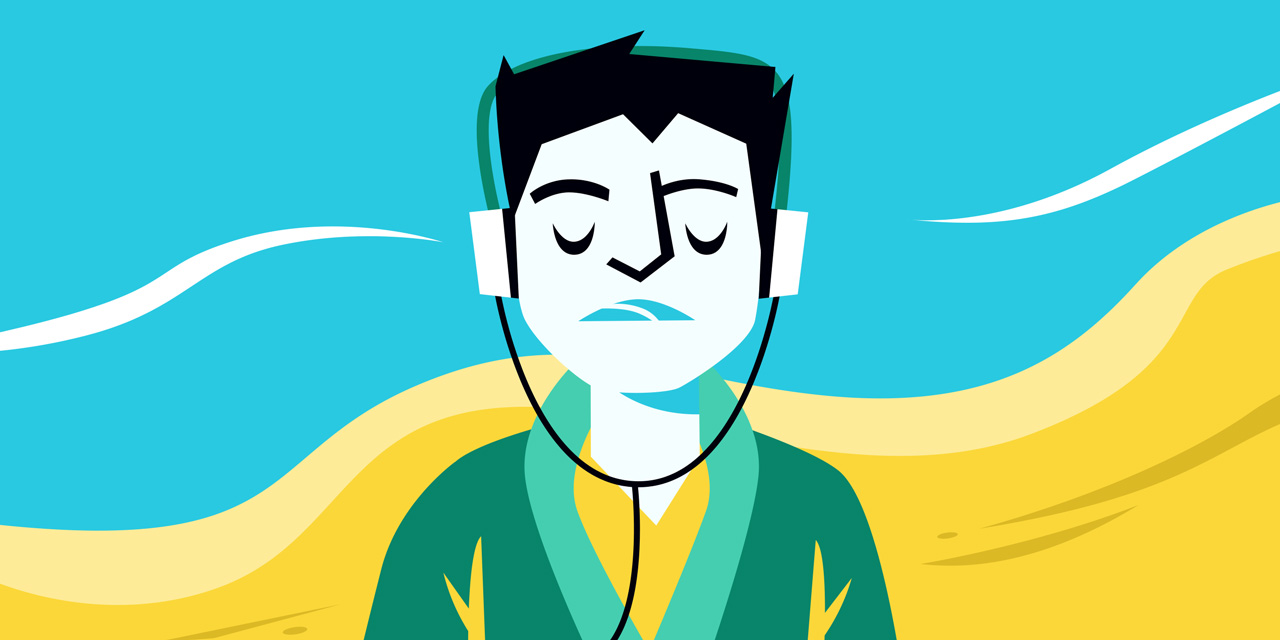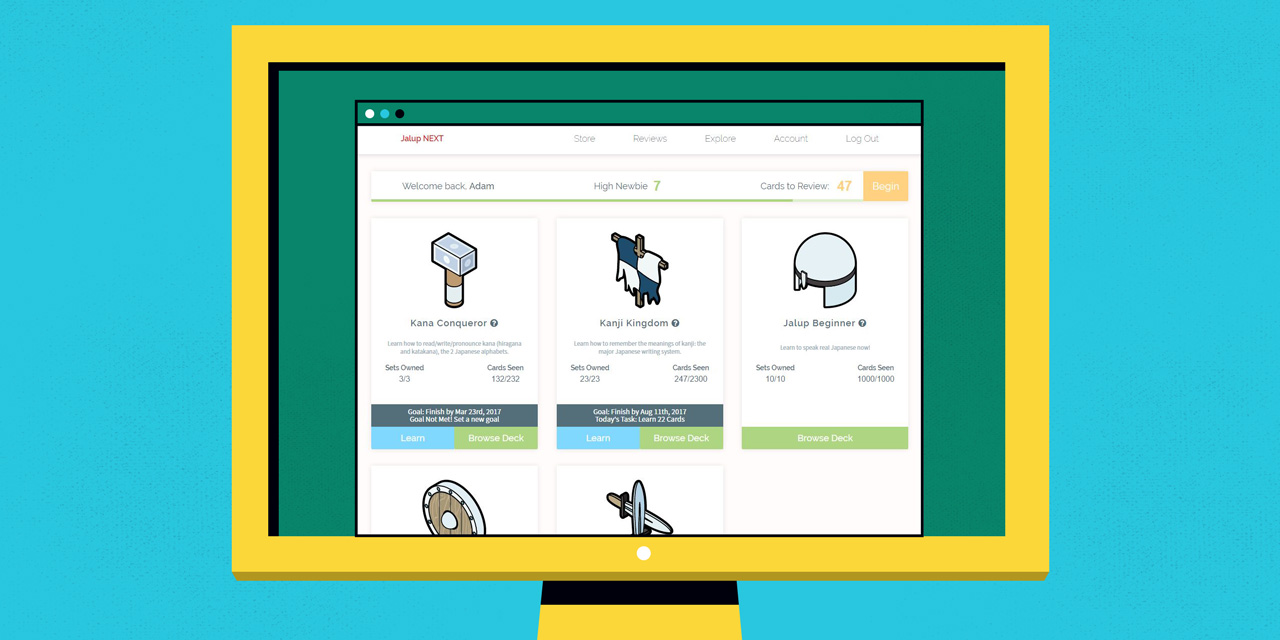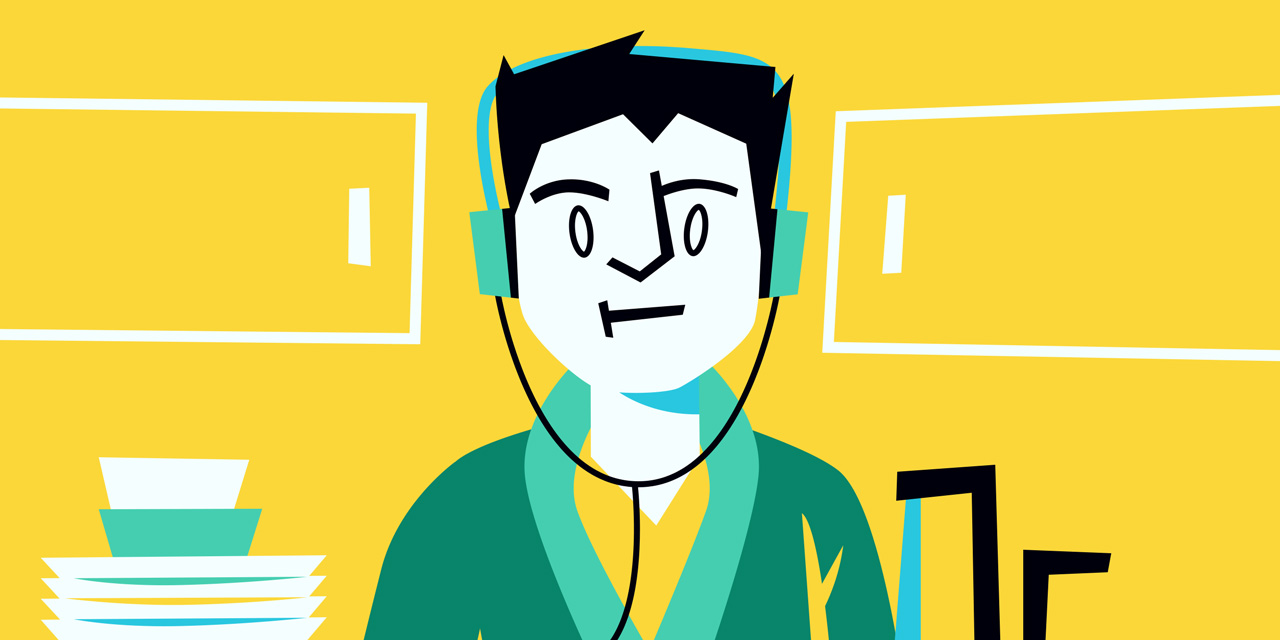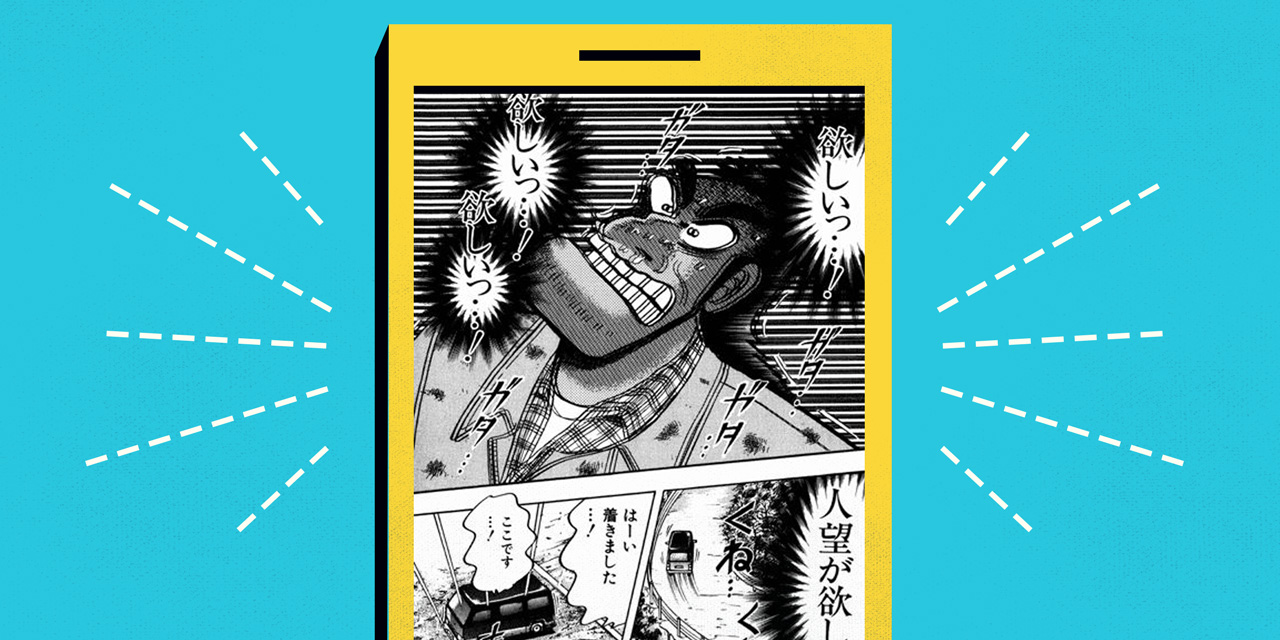In this series, Tofugu asks learners what Japanese learning resources and methods they use to study and why. Today, we talk to Adam, founder of Japanese Level Up and creator of Japanese study tool, Jalup NEXT.
We hope you'll be able to use his recommended tools and techniques to improve your Japanese. Take it away, Adam!
"It must be nice to be fluent. You don't have to do anything once you're there."
Whatttt? Where's the fun in that?
I started learning Japanese from nothing, foolishly expecting to be fluent within a year, even more foolishly thinking I was a Japanese master after three. Now, here I am 12 years after opening my first Japanese textbook, and I'm more thrilled than ever to continue studying.
There are a number of training methods I currently use. While some are for advanced learners, and some are unique to me, they might also work for you. After all, I try to integrate "study" into things I love doing anyway, so the whole process is enjoyable.
Here's what I use to study right now:
- Daily Shadow-Walking
- Japanese Learning with SRS Flashcards
- Card Linking on Jalup NEXT
- Continuous Listening Loop
- The Japanese E-book Life
Daily Shadow-Walking

I am a self-proclaimed shadow-walker. I love talking about this method because, c'mon. That cool name…
Shadow-walking is a combination of two things:
- Shadowing: Mimicking and repeating audio material, on a slight 1–2 second delay. It's like you're interpreting, except instead of translating from Japanese to English, you are "translating" Japanese to Japanese.
- Walking: Moving one leg in front of the other in rapid succession to acquire forward motion.
Shadowing is powerful – it develops a deeper listening ability, improves your speaking ability, and expands your passive and active vocabulary. However, shadowing is tiring, both physically and mentally. You are repeating what someone says for many minutes or hours with no break. You listen intently and talk non-stop, all at the same time.
- Language Shadowing
- Repeating audio material, on a slight 1–2 second delay. It's like you're interpreting, except instead of translating from Japanese to English, you are "translating" Japanese to Japanese.
I used to shadow in front of the TV with my favorite Japanese shows. It worked great until I got sleepy, and shadowing TV turned into just watching TV. Sitting still while shadowing limited the amount of time I could do it and was not particularly motivating. At the same time, I had been trying to get more exercise outdoors (Japanese tends to keep you inside). So I had a thought: Why not shadow while walking? That's like killing three or four birds with one stone.
I tried it, and fell in love. The time flew by. I had more energy to shadow. I had more energy to walk. I could easily shadow-walk for an hour or two non-stop. Doing either individually, I could barely reach half that.
I started shadow-walking in my neighborhood, but eventually moved on to parks, bays, beaches, and other places you'd never think to study Japanese. It's been over a year since I began. It's so good it should be a sport.
So far, my favorite Japanese listening materials to shadow-walk with are:
Podcasts:
- ドラゴンボール 超を毎週見ての感想 (for Dragon Ball Super fans)
- IT ニュース 六時五分 (for technology fans)
- 足立明穂の 週刊ITトレンドX (for technology fans who want even more discussion about technology)
- 週刊日経トレンディ (for market and product trend fans)
- 日野佳恵子のかえ 姉の 仕事と 恋愛の 法則 (for those looking for career and love advice)
These podcasts range in complexity based on topic, but the voice and sound quality are clear. They are always entertaining and you learn a lot.
Audio Books on Audible:
These are all self-improvement audio books, which I find to be the most enjoyable for shadowing. They work great, because there is no linear story, so you can start and stop any time without interrupting the flow of the book. And you're self-improving, which is always a plus.
If you are looking for audio novels, I recommend リング, ペンギン・ハイウェイ, and 40 翼ふたたび, all of which have engaging stories with characters that are easy to mimic.
Shadow-walking works for all levels. If you aren't ready for podcasts or audio books (which is probably best for intermediate level or above), you can start shadowing the audio from beginner textbooks. There is no preparation beforehand either. Just dive right in, start walking, and talking.
Japanese Learning with SRS Flashcards

I've used the spaced repetition software (SRS) flashcard app Anki for a decade. I haven't added new material to it in years, but I still review the tens of thousands of cards I've added already, which appear on the app's timed algorithm. SRS systems like Anki and WaniKani have the most value for beginners because they help you organize your memory and review what you've learned. But it takes on a new role when you become an expert.
With minor time upkeep, I get the following bonuses:
Fist-In-The-Air Victory
When you review a card in Anki, it shows you how far into the future the card will be pushed, on its new timed interval. It feels good to push back a card days, weeks, months, or even years.
You know what feels better?
Reviewing cards that won't be seen again for two decades.
Downtime Filler
Life gives us a lot of empty slots to fill: brushing teeth, waiting in line at the supermarket, waiting for someone else to get ready when you've been ready. These 30–90 second chunks are perfect for flashcard reviews.
Stress Busting
Stress can be softened by focusing on something else. When I'm in Anki review mode, I don't have the mental energy to spare for anything else, and the stress just melts away.
Nostalgia
Sometimes, you can remember exactly where you were and what you were doing when you first learned a flashcard. There are some cards that conjure vivid images of my past self, sitting in my tiny Japanese apartment, in my tiny living room, at my tiny table, in my tiny chair, learning a specific Japanese phrase. It's like time traveling.
Card Linking on Jalup NEXT

Since 2013, I have sold a series of original Japanese learner Anki decks through my website Japanese Level Up. In the beginning of 2017, I decided to create my own web app (Jalup NEXT), so I could run free with all the Japanese learning ideas I wanted to implement.
The learning system works by introducing you to one new concept at a time, often referred to as "i+1" or "information+1." You have to combine previously attained knowledge with your newest piece of knowledge to move forward.
You have to combine previously attained knowledge with your newest piece of knowledge to move forward.
I had to create thousands of pieces that would connect in a solvable and easy-to-understand way. Then I took every part of every sentence and definition, and made them clickable. When clicked, they bring up the card(s) on which you originally learned a specific piece of information.
I manually linked all this together. For every "click" in Jalup NEXT, I had to type out a piece of code. This has been my life lately.
It was painful at first. But the unexpected side effect of card linking has been a deeper understanding of how every word in a sentence interacts with every other word, in every instance possible. Through exposure, I get to see how and why grammar works the way it does, where it's confusing, where it could be less confusing, and how it all comes together.
Continuous Listening Loop

When you love Japanese like me, you can't get enough of listening to native material. For years, I've been taking whatever I listen to in a day and adding it to a continuously growing playlists. I add new material in and phase old material out. The result is a few hundred items I listen to on repeat for months at a time.
Why? Because I hate silence? Maybe. But there's a bigger reason: the more Japanese I listen to, the better I get. Not so far-fetched.
Hearing something for the second, third, or tenth time enables me to acquire increased comprehension. Every consecutive listen reveals a new layer I missed the previous time. It's like watching your favorite movie over and over. You learn new things about it with each viewing.
When you continuously listen like this, you have your own spaced repetition system built in, similar to online flashcards. You learn something when you first listen to it. Then it is repeated again and again, in different ways and settings. You unconsciously review it on timed intervals, no fancy computer algorithm required.
I follow a few rules for this method, though:
- I first actively listen to something (sit down and fully engage).
- The audio has to be from something interesting that I enjoyed, and is worth repeat listens.
- Repeat listens are done passively (e.g. while washing dishes, reading non-Japanese websites, writing things, writing this article, etc.)
- I don't listen while reading Japanese books, because I become too distracted.
This process was hard at first, and got in the way of other things. However, the more I listened, the more it became a natural part of my day. Some people say I take it too far, listening too much, and the results of this type of studying are questionable and limited. I reply, "I take everything too far. That's me."
You can get started with this in a number of ways. Set up an audio book or podcast playlist. Create YouTube playlists of your favorite Japanese YouTubers. Stream services like Hulu, Netflix, or Crunchyroll on your phone, and put it in your pocket so you're just listening to the sound. Be creative and you'll find yourself fully immersed in a continuous audio stream of Japanese joy.
The Japanese E-book Life

When I started reading e-books and e-manga, my life changed forever. I love Kindle Japan, and consider every single Japanese book an investment in myself. No one wants to spend excessive amounts of money on things they don't need. But with Japanese reading material, I ignore the cost. Your typical e-manga volume runs between $3-$5, and your typical novel runs between $3–$12. I'll buy manga and e-books any time, all the time, whatever time. Besides access to Japanese text, Japanese e-books give you a built in Japanese dictionary, the ability to copy/paste text, related recommendations, and free samples.
Reading makes your Japanese better. Reading a lot of Japanese makes your Japanese a lot better. It's that simple.
When reading Japanese e-books, I used to take every word I didn't know and put them into an Anki deck. Whenever I had the energy, I would also try and read everything out loud, acting out every scene or narration with passion. I felt this kept me more engaged with the material, and made me an active participant. As my vocabulary increased, these habits died down, but I recommend them to anyone trying to increase their Japanese ability.
How much do I read? A lot. I have a life, a family, a job, a business, and things going on. Even with all that, I still make time to read a novel or book a week, and when I'm on a manga binge, I multiply that number several times over.
There are two series I recommend to all learners:
Uchuu Kyoudai 宇宙兄弟 (Space Brothers)
The first is Uchuu Kyoudai 宇宙兄弟, or Space Brothers. In terms of difficulty, this is intermediate to advanced level material. However, it provides major boosts of motivation to anyone trying to achieve big life goals (like mastering Japanese). All the life lessons from these stories can be applied to your study troubles, and they always lifted me up when I needed it.
Saikyou Densetsu Kurosawa 最強伝説黒沢 (Strongest Legend, Kurosawa)
The second is Saikyou Densetsu Kurosawa 最強伝説黒沢, or Strongest Legend Kurosawa. In addition to being ridiculously funny, it manages to tell a heartfelt story, with barely any words on the page (and the words that do appear on the page are usually gigantic). Even beginners can enjoy it, despite the lack of furigana. It's a highly accessible, highly visual story.
Reading makes your Japanese better. Reading a lot of Japanese makes your Japanese a lot better. It's that simple.
That's me and how I study Japanese right now. If I had written this article three years ago, or if I were to write it three years from now, you'd get completely different Japanese resources and methods from me. My Japanese learning journey has been about changing the way I enjoy and expand my Japanese, and always doing it in a way that's best for me. Find out how you like to study right now, stick with it, and follow that path to glory.
That's been my mentality, and it's taken me places I never thought I would ever reach.
